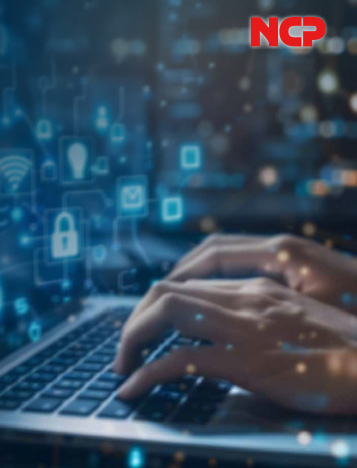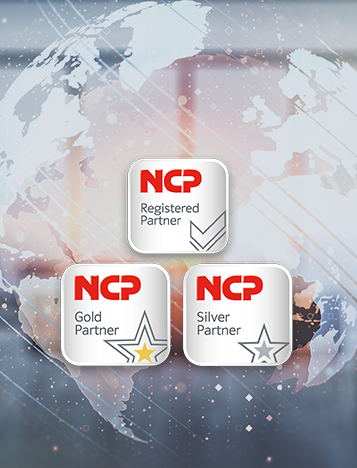You have questions – NCP provides answers
For technical questions, please contact our support via email: helpdesk(at)ncp-e.com
We've also compiled a selection of answers on the start-up and use of NCP VPN Clients, so we can solve frequently asked questions (FAQs) quickly.
General questions
Where can I find out which software version I am using?
In the client GUI, click on the “Help” menu” and then “Info”.
How can I display my company logo/project logo in the client GUI (custom branding option)?
By default the NCP Secure Entry Client GUI displays an additional information field that can be modified or removed. Clicking on the field opens an HTML file containing all the instructions for storing the company or project logo.
When installing the NCP Secure Enterprise client, the file "cbo.ini" is created in the installation directory (C:\ProgramData\NCP\SecureClient\config\cbo.ini). This file includes the installation instructions on how to add a company or project logo to the client GUI.
Is the NCP Secure Client compatible with third-party VPN gateways?
Yes, the NCP Secure Client is compatible with gateways based on the IPsec standard including IKEv1 and IKEv2 as well as protocol extensions in accordance with RFCs (XAUTH, EAP, IKEConfig, NAT-T).
However, as not all VPN vendors support all IPsec protocol extensions and as IPsec implementations may differ, please contact the vendor of your IPsec gateway to verify the compatibility of specific features.
Can client configuration files from other manufacturers be imported?
Yes. You can automatically import .pcf, .wgx, .spd or .ini files.
What happens when an external certificate storage device is removed (e.g. smart card, USB stick, SD card)?
The default setting automatically disconnects the VPN connection immediately. If the VPN connection should remain connected, this can be configured.
What should be considered when updating Windows 7 or 8.x to Windows 10 with respect to NCP Secure Clients?
When updating from Microsoft Windows 7, Windows 8 or Windows 8.1 to Microsoft Windows 10, it is essential that the NCP Secure Client is uninstalled before starting the update. We recommend backing up the configuration file and any user certificates separately.
Installation and updates
Where can I download the latest version of the NCP Secure Client?
You can download the client from the NCP Download Area under "Service > Download".
How do I activate the software after installation?
Please refer to the installation instructions.
How does the update process for NCP software work?
Updates may be free or subject to an additional charge. It depends whether the new software has new features or not:
- Updates are free if it is a new service release, e.g. 10.0 to 10.04
- Updates are chargeable for a new software version (major release), e.g. 10.10 to 11.10
An update key may be used to update a maximum of two major version steps, e.g. 11.x licenses can be updated to 13.x licenses by applying one update key. Update keys may only be applied one time.An update key may be used to update a maximum of two major version steps, e.g. 11.x licenses can be updated to 13.x licenses by applying one update key. Update keys may only be applied one time.
New major releases up to version 10.1x were indicated by the first decimal place of the version number, e.g. 10.00 to 10.10.
From version 11, major releases are now indicated by the integer of the version number e.g. 11.x to 12.x.
Versions
New versions include significant changes, performance or function enhancements and are subject to charges. Updates require a new client license key (LK).
Service Release
New service releases include bug fixes and minor improvements and are not chargeable. They do not require a new license key (LK).
Note
The version of the license key and the version of the software in use need to match, e.g. both for version 13.x.
You can find a list of all major releases that are chargeable here. For more information about the license update, please refer to our Service pages.
In principle, there is no obligation to update.
How can I import an existing configuration when reinstalling the NCP Secure client?
You can easily import existing client settings by simply copying the ncpphone.cfg file. This file contains all settings for the NCP client. You can find this file under the following paths:
Windows 8, 8.1 and 10
\Program Files (x86)\ncp\secureclient
From client version 10.10:
\Program Files\ncp\secureclient
From client version 12.0:
C:\ProgramData\NCP\SecureClient\data
Windows Vista/Windows 7 (32 bit)
\program files\ncp\secureclient
Windows Vista/Windows 7 (64 bit)
\program files (x86)\ncp\secureclient
Windows XP (32 bit)
\programme\ncp\secureclient
OS X/macOS
/Library/Application Support/NCP/Secure Client/
Windows Mobile (Configuration PC Windows XP )
Enterprise Client
\Dokumente und Einstellungen\Benutzername\Anwendungsdaten\NCP\Enterprise Configuration Manager CE\bin\
Entry Client
\Dokumente und Einstellungen\Benutzername\Anwendungsdaten\NCP\Entry Configuration Manager CE\bin\
Windows Mobile (Konfigurations-PC Windows Vista/7)
Enterprise Client
\Benutzer\Benutzername\AppData\Roaming\Ncp\Enterprise Configuration Manager CE\bin\
Entry Client
\Benutzer\Benutzername\AppData\Roaming\Ncp\Entry Configuration Manager CE\bin\
Software activation
What does software activation mean?
To use the client software, you need a serial number and a license key. Client software license keys have a unique version number. The features available in the client software is determined solely by the license key. The client license is activated by the activation code, which is transferred to the end device via an Internet connection.
In which cases is software activation necessary?
- When reinstalling the NCP Secure Entry Client
- In the event of significant changes to the hardware
- If you have received a new license key for a major update
What causes software activation to fail?
- Problem: The license key version is higher than the installed software version
Solution: Software update - Problem: Transfer error
Solution: Retry and notify support if necessary
Why can't I use all the software features?
Problem: The license key version is lower than the installed software version.
What data is sent during the software activation?
Only hardware information (e.g. serial number of the CPU, MAC address, etc.) is recorded during the software activation process. User data is not collected (software activation is not the same as software registration.)
What are the options for software activation?
Software can be activated online or offline. Please refer to this file for more information.
How can a license key be reused if the hardware has been replaced (due to update or defect)?
If a license has already been activated for an end device, but it is no longer in use, you can request that the license is reactivated via the license reactivation request form. You can deactivate the NCP Secure Entry Client (Win 32/64) and the NCP Exclusive Entry Client to use the software on new hardware. To do this, click in the "help-menu" on "Deactivate client ..." and follow the instructions.
You can request reactivation of a license (grace activation) by using the license reactivation request form.
Can a license key be reused if the user of the end device changes?
The software does not need to be activated again if the device/hardware remains the same – even if the software is reinstalled (but with the same operating system), no further activation is required. However, the license key must be re-entered. In all other cases, the above provision applies.
Is the number of license key activations limited?
A limit of two license activations applies – one of which is the "Grace activation" described above.
Features
How does the NCP Secure Entry Client differ from the NCP Secure Enterprise Client?
Both clients have similar features. The NCP Secure Enterprise Client can also be managed centrally and is suitable for large environments with many users. Please refer to this page for more details.
Can I use public Wi-Fi securely with the NCP Secure client?
Yes. The NCP Secure clients have a secure HotSpot Logon feature as well as an integrated personal firewall which supports friendly net detection (FND). Learn more about this feature here.
How do NCP Secure Clients handle friendly/unknown networks?
Please refer to the automatical assinging of firewall rules PDF.
Does the NCP Secure Entry Client offer a solution for overlapping IP networks?
Yes, as an option.
Is there any way to disable VPN, Internet access, and Personal Firewall settings to protect users from configuration errors?
Yes. Please refer to the "Configuration Locks Entry Client" PDF for more information about the NCP Entry Client. Please refer to the "Parameter Locks Enterprise Client" PDF for more information about the NCP Entry Client.
NCP Exclusive Remote Access Clients for Juniper SRX/vSRX
Is the NCP Exclusive Remote Access Client compatible with third-party VPN gateways?
No, NCP Exclusive Remote Access Clients can only be used with Juniper SRX Series Gateways.
Where can I find out which software version I am using?
Via the client GUI. In the client, click on the “Help” menu” and then “Info”.
Can I use public Wi-Fi securely with the NCP Exclusive Remote Access Clients?
Yes. The NCP Exclusive Remote Access clients have an integrated dynamic personal firewall that supports friendly net detection (FND). Learn more about this feature here.
How can I display my company logo/project logo in the client GUI (custom branding option)?
By default the NCP Exclusive Remote Access Client GUI displays an additional information field that can be modified or removed. Clicking on the field opens an HTML file containing all the instructions for storing the company or project logo.
When installing the NCP Exclusive Remote Access Client, the file "cbo.ini" is created in the installation directory (C:\ProgramData\NCP\Exclusive Remote Access Client\config\cbo.ini). This file includes the installation instructions on how to add a company or project logo to the client GUI.
Please refer to the NCP Enterprise Client GUI PDF for more information.
How do NCP Exclusive Remote Access Clients handle friendly/unknown networks?
Please refer to the “Automatic Assignment of Firewall Rules” PDF.
Do I need a personal firewall in addition to the NCP Exclusive Remote Access Client for mobile computing?
No. All NCP VPN clients already have an integrated a personal firewall, which can also be managed centrally for the Exclusive Remote Access Client.
Does the NCP Exclusive Remote Access Client recognize secure networks and automatically assign the correct firewall settings?
Yes, please refer to the "Automatic Assignment of Firewall Rules" PDF.







